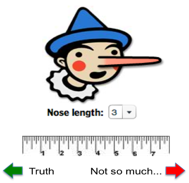 According to a “Science of Honesty” study presented at the American Psychological Association’s 120th Annual Convention, lying less is linked to better health.
According to a “Science of Honesty” study presented at the American Psychological Association’s 120th Annual Convention, lying less is linked to better health.
Kelly and co-author Lijuan Wang, PhD, both of Notre Dame, conducted the honesty experiment over 10 weeks with a sample of 110 people, of whom 34 percent were adults in the community and 66 percent were college students.
Approximately half the participants were instructed to stop telling major and minor lies for the 10 weeks. The other half served as a control group that received no special instructions about lying. Both groups came to the laboratory each week to complete health and relationship measures and to take a polygraph test assessing the number of major and white lies they had told that week.
The results?
The researchers found that in the “no lies” group, the fewer lies the study participants told, the better their health. For example, telling fewer white lies was associated with fewer feelings of tension or melancholy, as well as fewer health problems like headaches and sore throats, the researchers found.
And overall, telling fewer lies over the study period was linked with feeling more honest and having improved relationships.
Moral of the story? Honesty seems to always be the best policy, even when it comes to your health!

